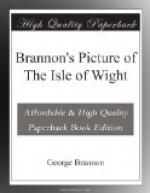* * * * *
We now open a general view of the fast-improving town of ...
VENTNOR.
>>_This is the chief resting-place between Shanklin and Niton. The_ CHURCH, and the COVE, are the most interesting features.
* * * * *
Ventnor has risen into importance with a rapidity greater than any other place in the island: for as late as the year 1830 it numbered but about half-a-dozen cottages, one hotel, a small inn, and the accompaniment of a humble grist-mill, so necessary in a retired hamlet as this was then. But such has since been the eagerness for building, that land for the purpose which was at that time sold for L100 per acre, soon advanced to 300 or L400; latterly the price has risen at the rate of 800 to L1000 per acre for the more eligible sites. And at present there are three first-rate hotels and several minor inns; well stocked shops in almost every line of business: and medical men established on the spot. Several streets of considerable extent are completed, others are rapidly progressing; and much has also been done in the way of public improvements, such as paving, lighting, &c. The new Esplanade, on the beach, cannot fail to prove a delightful convenience both to the inhabitants and visitors at Ventnor.
It is greatly indebted for its prosperity to Dr. Clarke’s popular Treatise, to which we have already referred (p. 16,) when speaking of the climate generally. Its progress was still more accelerated by the interest which the proprietor of Steephill Castle, John Hambrough, esq., took in its success, by erecting a handsome church, a large free-school, parsonage, &c.
Building being still carried on with undiminished speculation, the general appearance of the town must be consequently anything but agreeable—nor has there been the lapse of sufficient time for the growth of the shrubberies (however genial the climate,) to attain that size which would afford the relief of even a partial screen. Little therefore can be particularized under the present changing aspect of the place.
Among the buildings which attract attention in entering by the old road, are the connected range called St. Boniface Terrace, occupying a commanding situation, and the houses concurring in one general design: and below, some extensive erections, of rather a novel appearance to the untraveled eye, being strictly in imitation of the airy and picturesque style of the Italian villa.
The somewhat confused appearance of Ventnor is no doubt owing to its unexpected advance having prevented the adoption of any uniform ground-plan, as would no doubt have been done could the proprietor of the land have foreseen the magnitude to which the place was so soon to extend,—for in this respect a considerable improvement is visible in the latest-erected part of the town. The most regularly laid-out streets are near the shore: and one branch-road runs by the edge of the sea-cliffs for about half a mile towards Bonchurch, thus affording the houses an uninterrupted view of the sea.




